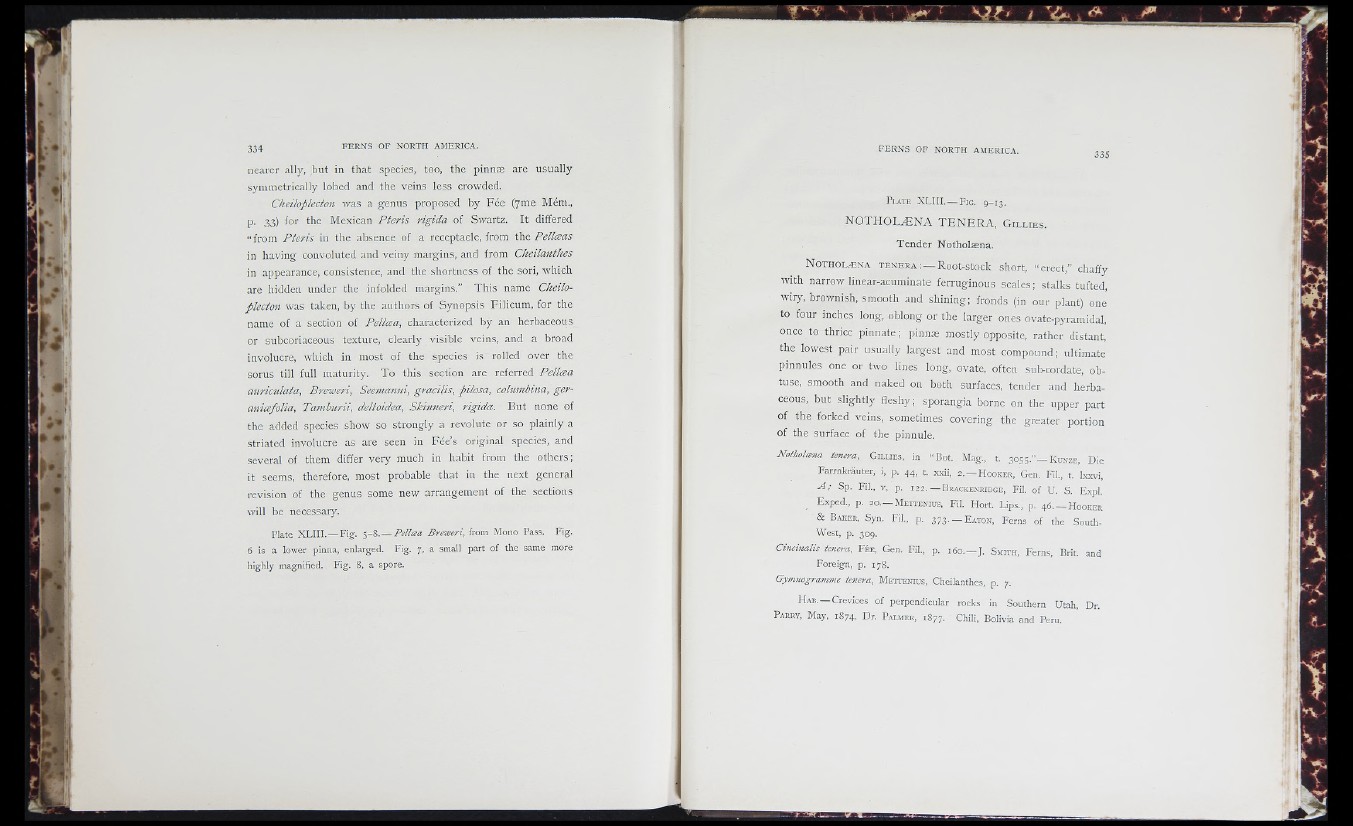
\ r V»
r i
p ;
p • ,1
# •
I » « '
nearer ally, but in that species, too, the pinnæ are usually
syninietrically lobcd and the veins less crowded.
Cheiloplecton was a genus proposed by Fée (yme Mém.,
p. 33) for the Mexican Pteris rigida of Swartz. It differed
“ from Pteris in the absence of a receptacle, from Üut Pellæas
in having convoluted and veiny margins, and from Cheilanthes
in appearance, consistence, and the shortness of the sori, which
are hidden under the infolded margins.” This name Cheiloplecton
was taken, by the authors of Synopsis Filicum, for the
name of a section of Pellæa, characterized by an herbaceous
or subcoriaceous texture, clearly visible veins, and a broad
involucre, which in most of the species is rolled over the
sorus till full maturity. To this section are referred Pellæa
auriculata, Breweri, Seemanni, gracilis, pilosa, colwmbina, ger~
aniæfolia, Tamburii, deltoidea, Skinneri, rigida. But none of
the added species show so strongly a revolute or so plainly a
striated involucre as are seen in F é e s original species, and
several of them differ very much in habit from the others;
it seems, therefore, most probable that in the next general
revision of the genus some new arrangement of the sections
will be necessary.
Plate X L I I I .— Fig. ^ - i .— Pellæa Breweri, from Mono Pass. Fig.
6 is a lower pinna, enlarged. Fig. 7, a small part of the same more
highly magnified. Fig. 8, a spore.
P l a t e X L III. — F ig . 9 - 1 3 .
NO THO LÆ NA T E N E R A , G i l l i e s .
Tender Notholæna.
N o t h o l æ n a t e n e r a : — Root-stock short, “ erect,” chaffy
with narrow linear-acuminate ferruginous scales; stalks tufted,
wiry, brownish, smooth and shining; fronds (in our plant) one
to four inches long, oblong or the larger ones ovate-pyramidal,
once to thrice pinnate ; pinnæ mostly opposite, rather distant,
the lowest pair usually largest and most compound; ultimate
pinnules one or two lines long, ovate, often suNcordate, obtuse,
smooth and naked on both surfaces, tender and herbaceous,
but slightly fleshy; sporangia borne on the upper part
of the forked veins, sometimes covering the greater portion
of the surface of the pinnule.
G il l i e s , in “ Bot. Mag., t. 3 0 5 5 . ” — K u n z e , Die
Farrnkrauter, i, p. 44, t. xxii, 2. — H o o k e r , Gen. Fil., t. Ixxvi,
A : Sp. Fil., V, p. 1 2 2 . — B r a c k e n r id g e , Fil. of U . S. Expl.
Exped., p. 20. — M e t t e n iu s , Fil. Hort. Lips., p. 4 6 .— H o o k e r
& B a k e r , Syn. Fil., p. 3 7 3 . — E aton, Ferns of the South-
West, p. 30 9 .
Cmeinalis tenera. F e e , Gen. Fil., p . 1 6 0 .— J . S m ith , Ferns, Brit, and
Foreign, p. 178.
Gymnogramme tetterà, M e t t e k iu s , Cheilanthes, p. 7.
H a b . — Crevices of perpendicular rocks in Southern Utah, Dr.
P a r r y , May, ¡874, Dr. P a lm e r , 1877. Chili, Bolivia and Peru.